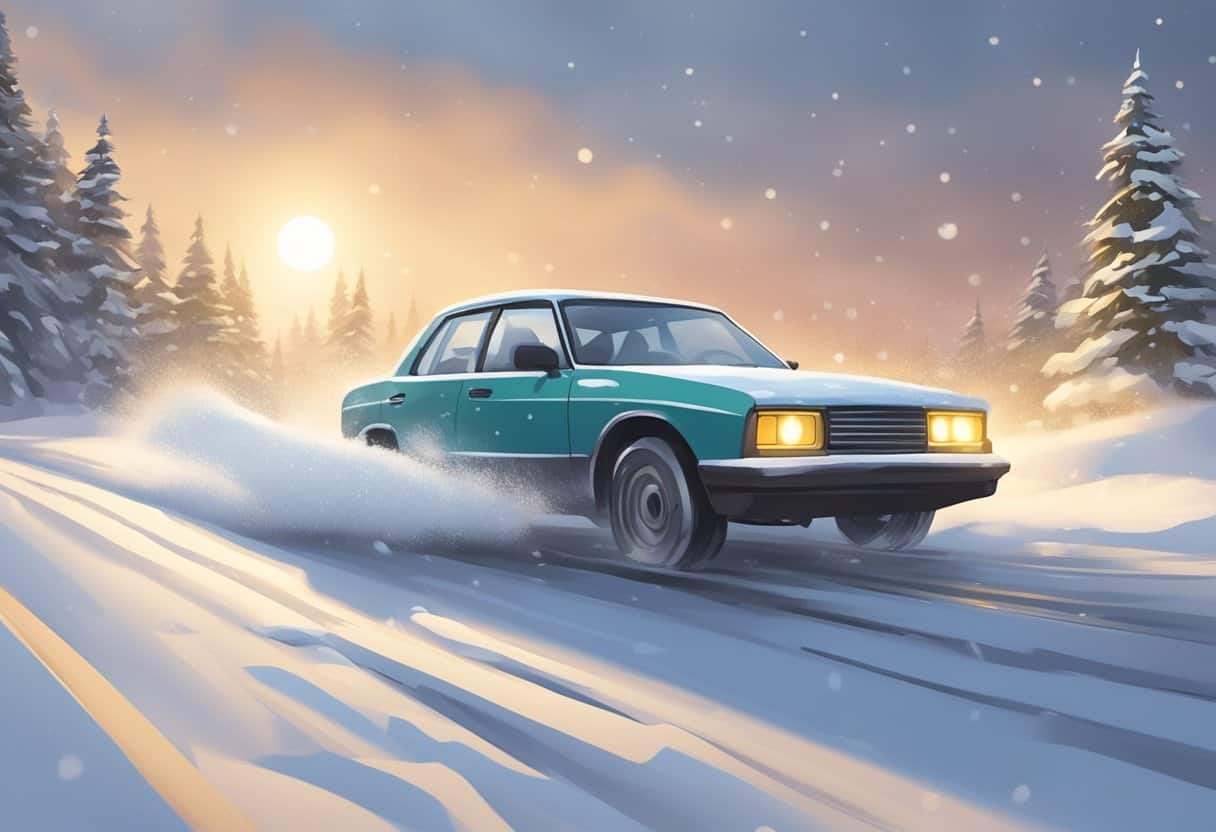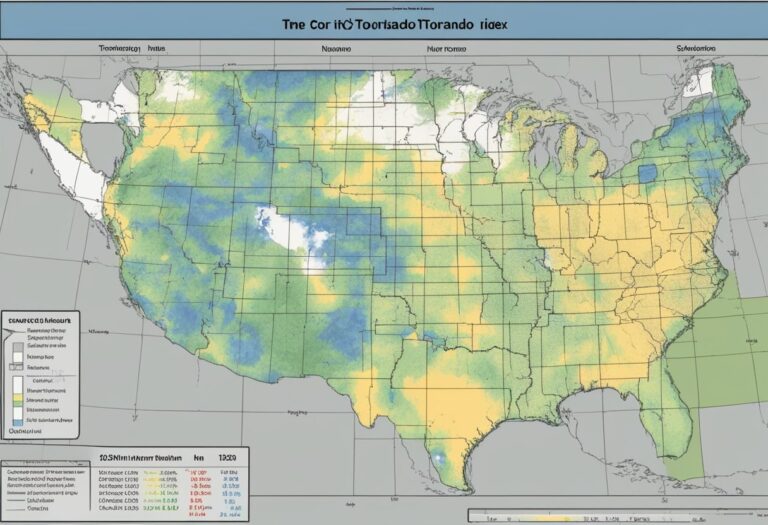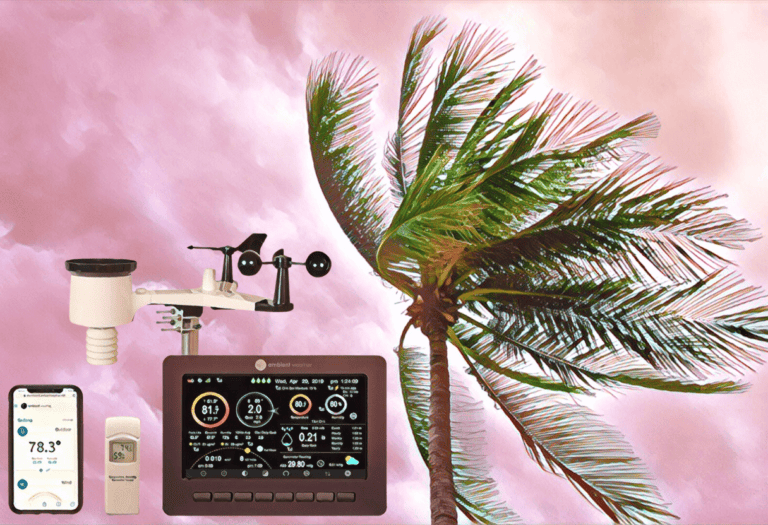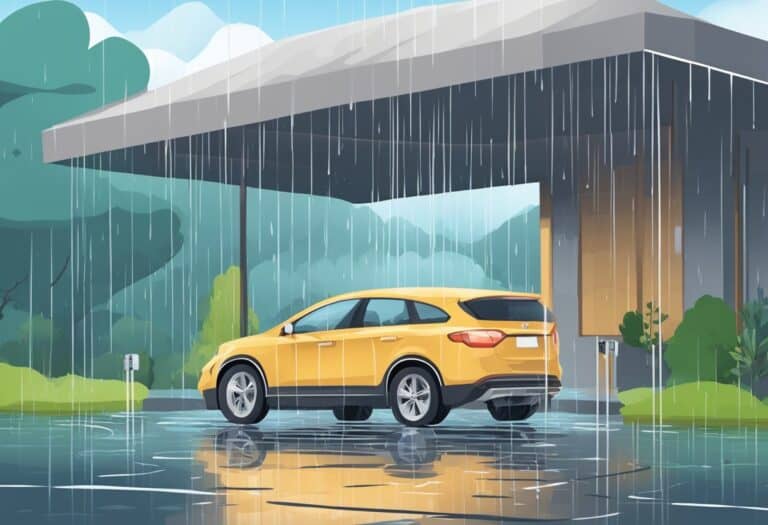Winter brings the joy of snowfall, the excitement of holidays, and the magic of the season’s first snowflakes.
However, it also presents a significant challenge for drivers—navigating the roads safely when they’re covered in snow. Driving in snowy conditions requires not just skill and patience, but also a sound understanding of the risks and the necessary precautions. Proper preparation before you set out can make all the difference. Ensuring your vehicle is equipped for the season, from tires to wipers, is just the starting point.
Once on the road, safe driving techniques become critical. As snow blankets the streets, it masks road markings, obscures hazards, and reduces traction, which demands a heightened sense of awareness and a more cautious approach to driving. Adapting your driving strategy can prevent accidents when you’re faced with winter’s unpredictable weather.
In addition to adjusting your speed and increasing following distances, it’s also vital to know how to manage oversteer and understeer, how to safely brake on icy surfaces, and what to do in case of an emergency stop or if you become stranded.
When driving in snow, ensure your vehicle is winter-ready with proper tires and a fully charged battery. Adapt driving techniques by reducing speed, increasing following distance, and knowing how to handle skids. Carry an emergency kit and stay informed about weather conditions for safe winter travel.
Preparing Your Vehicle
Before you brave the snow-covered roads, ensure your vehicle is equipped to handle the harsh conditions. From maintaining proper tire traction to ensuring clear visibility, attention to detail can dramatically increase your safety.
Tires and Traction
Tires: Crucial for safe winter driving, install snow tires or winter tires, as they offer better grip. Tire Pressure: Keep tire pressure at manufacturer-recommended levels to maximize traction.
Battery and Electrical System
Battery: Cold diminishes battery power; ensure yours is fully charged. Consider a battery charger for emergencies. Ignition System and Lights: Regularly check that your ignition system works and that all lights, including headlights, are functional.
Visibility
Ensure maximum visibility by checking that your windshield wipers are in good condition and the wiper fluid is full. Always have an ice scraper and brush to clear the windows and roof of snow and ice.
Survival and Emergency Kits
Keep a blanket, extra gloves, and a flashlight in your vehicle. It’s also wise to carry flares and a comprehensive emergency kit with supplies that could be lifesaving if you’re stranded.
Under the Hood
Inspect your vehicle’s cooling system, and keep the gas tank at least half full to prevent fuel line freeze-up. Check the exhaust system to avoid dangerous blockages by snow and ice.
Additional Items
Carry a bag of sand, cat litter, or another abrasive material to provide extra traction if you get stuck. Don’t forget a compact snow shovel for digging out of snow drifts.
Technical Preparations
Familiarize yourself with your vehicle’s traction control and anti-lock braking system (ABS). Understanding how these features function can help you maintain control on slippery roads.
Removing Snow and Ice Accumulation
Regularly remove snow and ice to prevent accumulation that can affect your vehicle’s balance and traction. Use a dedicated snow shovel and brush to clear your vehicle before driving.
Safe Driving Techniques
When driving in snowy conditions, your safety depends on understanding the challenges posed by icy roads and limited visibility. Employing the proper techniques can significantly reduce the risks involved.
Speed and Control
Slow down when driving in snow. Your ability to react to sudden changes is greatly diminished on icy roads. Avoid using cruise control and make any steering or speed adjustments gradually to reduce the risk of skids.
Braking and Skidding
Use your brakes gently to avoid triggering a skid. If you do find yourself skidding, remain calm and steer in the direction you want to go. For cars without anti-lock brakes (ABS), pump the brakes gently instead of applying steady pressure.
Following Distance
Increase your following distance to at least five to six seconds to provide ample stopping distance. This extra space can prevent collisions if the car in front of you stops suddenly or if you encounter black ice.
Navigating Through Winter Conditions
Always ensure your vehicle is equipped with a GPS or map to help guide you through unfamiliar routes. Postpone non-essential travel during severe weather. If driving is unavoidable, let someone know your estimated arrival time and route.
Driving at Night
Maximize your visibility by keeping your lights and headlights clean and functional. Your headlights will help you see and be seen in heavy snowfall. Dim your dashboard lights to improve your visibility of the road ahead.
Dealing with Emergencies

When driving in the snow, being prepared for emergency situations is crucial. Equip your vehicle with tools and materials to handle common winter challenges and know the steps to ensure your safety.
If You Get Stuck
- Don’t Spin Your Wheels: This will only dig you in deeper. Instead, turn your wheels from side to side to push the snow out of the way.
- Use Traction Aids: Place sand, cat litter, or any other abrasive material behind your tires to help get traction.
- Shovel Snow Away: If possible, shovel snow away from the tires and under the car to prevent compaction and ice formation.
In Case of Breakdown
- Stay with Your Vehicle: In winter weather, your car is a shelter. Avoid leaving to search for help unless you see a building close by where you can call for assistance.
- Check the Exhaust Pipe: Ensure it’s not blocked by snow, as this can lead to a build-up of carbon monoxide inside the vehicle if you’re idling to stay warm.
- Signal for Help: Use flares or reflective triangles to make your vehicle more visible.
Stranded in a Vehicle
- Conserve Fuel: Run the engine and heater sparingly; use blankets to conserve body heat – having a couple of blankets in your emergency kit can be a lifesaver.
- Stay Visible: Turn on the vehicle’s headlights or interior light at night to help rescuers see you.
- Avoid Overexertion: Trying to push or dig your vehicle out can get you sweaty which can lead to a dangerous chill when the sweat freezes.
Signaling for Help
- Use Your Cell Phone: Call 911, AAA, or a mechanic if you have service. Always keep a charger in your emergency kit.
- Make Noise: If you don’t have a cell phone, or if you’re in an area with poor service, use a whistle or horn to draw attention to your location.
- Be Visible: Keep dome lights on if it’s not daylight, and place flares and triangles outside to alert others of your presence.
Post-Drive Maintenance
After driving in snowy conditions, it is crucial to perform post-drive maintenance to ensure your vehicle remains in good working order and to avoid future safety hazards. Proper post-drive checks and cleanup can extend the lifespan of key components such as tires and brakes, while also maintaining optimal vehicle performance.
Checking Your Vehicle
Inspect your tires for any snow or ice buildup that could affect traction and ensure that your tire pressure is at the recommended level, as cold weather can cause the pressure to drop. Check your brakes for functionality and any signs of wear or unusual noises, as they are critical for safe stopping in snowy conditions.
- Tires: Remove snow and check for pressure.
- Brakes: Listen for noise and check stopping capability.
Vehicle Clean-Up
Remove all snow and ice from the windows, roof, and lights of your vehicle to maintain visibility and prevent hazards for other drivers. Cleaning off the cooling system’s external components, such as the radiator, will help prevent overheating and improve long-term performance.
- Windows/Roof: Clear snow and ice completely.
- Lights: Ensure all lights are visible and functioning.
- Cooling System: Inspect for blockages.
Monitoring Vehicle Performance
Periodically monitor your battery power as the cold can drastically reduce its capacity. It’s essential to keep your gas tank at least half full to prevent fuel line freeze-up. Observe any changes in your vehicle’s performance, and check for any dashboard warning lights that may indicate issues with the car’s systems.
- Battery: Check power levels and charge if necessary.
- Gas Tank: Maintain at least half full.
- Performance: Watch for warning lights and changes.
Consulting a Professional
If you’re uncertain about the condition of any component, such as the cooling system, or if you identify issues with your tires or brakes, consult a mechanic promptly. A professional can give your vehicle a thorough examination and address any problems before they worsen.
- Mechanic: Seek professional advice for any concerns or detected issues.
Concluding Advice
To say farewell to winter driving worries, careful consideration of your driving habits and conditions is key. This section arms you with practical advice to navigate snowy roads with confidence.
Reviewing Driving Habits
Your safety on snowy roads hinges on adapting your driving habits. Slow down to maintain control and minimize distractions; this means silencing your phone and focusing solely on the road. Quick maneuvers and sharp braking often lead to accidents, so opt for gentle turns and gradual stops.
Planning and Preparedness
Before venturing out, check the weather forecast and plot your journey using a GPS or map to familiarize yourself with the route. Avoid non-essential travel during severe winter weather, but if travel is necessary, ensure your vehicle is equipped with snow chains and an emergency kit. Remember, preparedness is the guardian of safe travel.
Legal Considerations
Be cognizant of local laws regarding winter weather driving. Some jurisdictions mandate the use of snow chains or prohibit idling for extended periods, both to ensure public safety and reduce carbon monoxide emissions. Compliance is not just lawful—it could save lives.
Environmental Awareness
Lastly, understand the environment you’re driving in. Snow and ice can drastically alter driving conditions, requiring you to be vigilant and reactive. Keep ample distance from the vehicle ahead, as stopping distances can increase up to tenfold on ice. Stay tuned to local weather alerts, and if conditions worsen, find a safe place to wait it out.
Additional Resources
When embarking on a journey through snowy conditions, your preparation can make a significant difference in ensuring a safe trip. Here’s a condensed guide with essential resources to consider:
AAA Membership
Ensure your AAA membership is active for roadside assistance. They provide valuable services, such as towing, jump-starts, and lockout assistance, which can be crucial if you encounter car troubles in the snow.
Mechanic Check-Up
Before winter sets in, it’s important to have a mechanic inspect your vehicle. This check-up should include your battery, antifreeze levels, heater, brakes, and tire tread depth.
Emergency Supplies
Keep a pack of emergency supplies in your car, including:
- Blankets
- Non-perishable food
- Water
- First aid kit
- Flashlight with extra batteries
Navigation Tools
A reliable GPS system can help you navigate through unfamiliar routes. Additionally, keep an updated physical map as a backup in case of electronic failures.
Visibility Aids
To enhance your car’s visibility to others during an emergency stop, use flares or reflective warning triangles to alert oncoming traffic.
Communication
Always have a way to communicate in case of an emergency. Carry a fully charged mobile phone with an extra power bank or a car charger.
By equipping yourself with these resources, you can tackle the challenges of driving in the snow more confidently. Preparation enhances safety, allowing for a more controlled response to any unforeseen winter driving hurdles.
Checklist Before Hitting the Road
Before you venture out into snowy conditions, there are essential checks and preparations you should perform to ensure a safer driving experience. Here’s what you need to cover:
Traction and Tires:
- Check tire pressure: Cold weather can reduce tire pressure, so verify it matches the recommended levels.
- Inspect tire tread: Ensure your tires have more than 6/32 inches of tread for proper snow traction.
- Consider snow chains: If you’re heading into severe snow, have snow chains available for extra grip.
Visibility and Lights:
- Headlights and taillights: Clear any snow and ensure all lights work to maintain visibility.
- Windshield wipers: Replace old blades and fill up with freeze-resistant wiper fluid.
Mechanical Systems:
- Brakes: Make sure your brake system functions correctly and brake pads are not worn out.
- Battery: Cold weather strains batteries. Check charge levels and replace if necessary.
Essential Supplies:
- Emergency kit: Include items like a blanket, flares, and jumper cables.
- Sand or cat litter: Useful for extra traction if you get stuck.
General Preparations:
- Remove all snow and ice: A clean car prevents snowfall from your vehicle while driving.
- Full gas tank: Maintain at least half a tank to prevent fuel line freeze.
- Cruise control: Avoid using cruise control on slippery surfaces to maintain direct control.
Planning and Navigation:
- GPS and maps: Ensure your navigation is set up, but be ready for detours or poor conditions.
- Keep a safe following distance: Increase it beyond the normal recommendation to allow for increased stopping distance on snow.
By following this checklist, you prepare yourself not just to prevent accidents like a skid, but also to handle emergencies effectively. Always adjust your driving habits to match the conditions of the road.
Driving Strategies to Avoid
When you’re navigating roads blanketed in snow, certain driving behaviors should be avoided to maintain safety. Adopting a cautious approach can make significant differences in your driving experience.
-
Sudden Movements: Abrupt steering, braking, or accelerating could cause you to lose control. Maintain steady, smooth actions to avoid slipping on black ice, which is treacherous and often invisible.
-
Non-Essential Travel: If conditions are poor, re-evaluate the necessity of your trip. Postponing non-essential travel can keep you and others safe.
-
Minimize Distractions: Distractions can be even more dangerous in snowy conditions. Keep your focus purely on the road and the task of driving.
-
Cruise Control: Using cruise control on slick surfaces can lead to difficulties in maintaining control. It’s better to manage your speed manually.
Steering Clear of Safety Risks
| Avoid | Because |
|---|---|
| Sudden Movements | Increases risk of skidding. |
| Non-Essential Travel | Reduces overall road hazards. |
| Minimize Distractions | Essential for reacting to quick changes. |
| Cruise Control on Snow/Ice | May cause loss of traction control. |
By adhering to these avoidance strategies, you improve your odds of reaching your destination without incident. Remember, even if you’re comfortable driving in snow, others may not be as prepared or skilled. Your cautiousness adds to everyone’s safety.
Frequently Asked Questions
Driving in snowy conditions requires special attention to safety and vehicle preparedness. The following FAQs address important tactics and considerations for winter driving.
What are the best techniques for maintaining control of a vehicle when driving on icy roads?
To maintain control on icy roads, reduce your speed and increase your following distance. Apply the brakes gently to prevent skidding, and if you have anti-lock brakes, avoid pumping them.
How can you prepare your car for driving in winter conditions?
Ensure your car is ready for winter by checking the battery, tire tread, and windshield wipers. Install winter tires for improved traction and keep an emergency kit that includes a snow shovel and de-icing tools.
What are the essential safety tips for beginners learning to drive in snowy weather?
Beginners should practice in a snow-free parking lot to get a feel for their vehicle’s handling in the snow. Always clear your car of ice and snow before driving to maintain visibility.
How do different drivetrains, like 4WD, AWD, and 2WD, affect handling in the snow?
Four-wheel drive (4WD) and all-wheel drive (AWD) can provide better traction in snowy conditions, helping to prevent your vehicle from getting stuck. However, front-wheel drive (FWD) in a 2WD vehicle also performs well in the snow by placing the weight over the driving wheels.
What steps should you take if your vehicle begins to skid on ice?
If you start to skid, remain calm and steer in the direction you want to go. Avoid slamming on the brakes, as this can exacerbate the skid.
What are the common mistakes to avoid when driving during a snowstorm?
Avoid driving too quickly for the conditions, following too closely, and braking abruptly. It’s also a mistake not to adjust your schedule to allow extra time for travel during a snowstorm.







